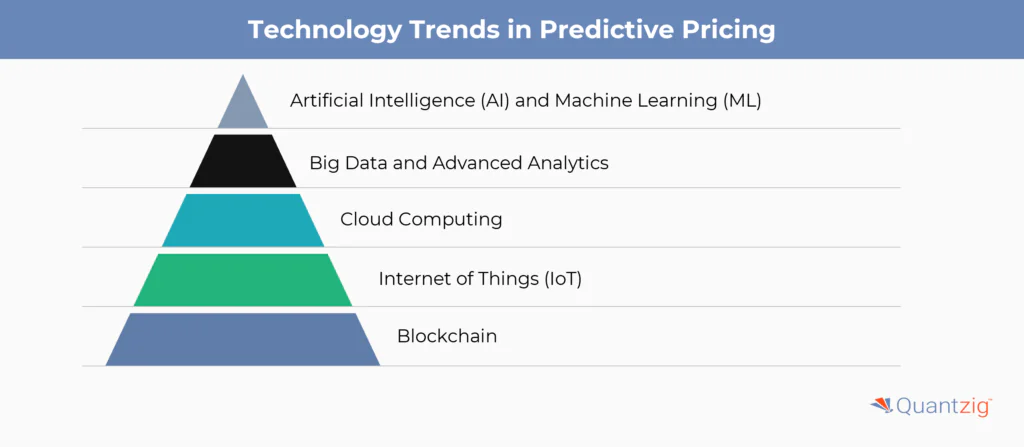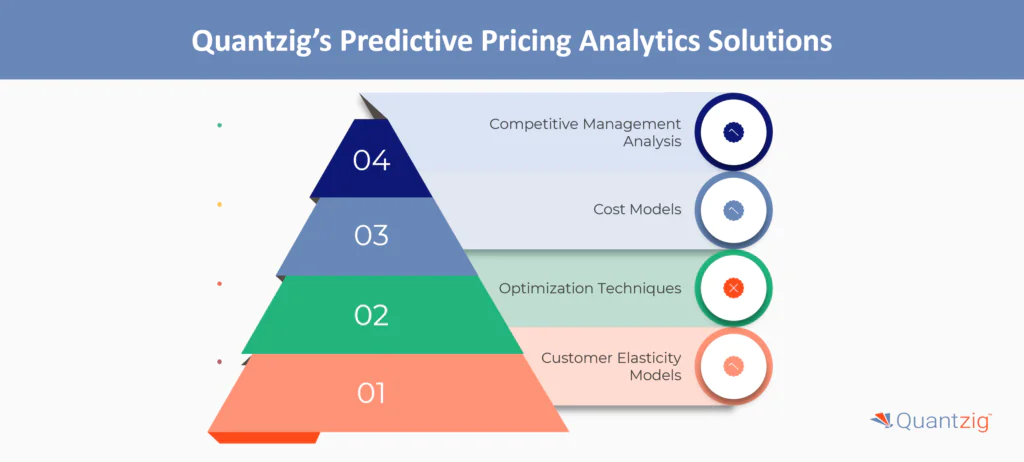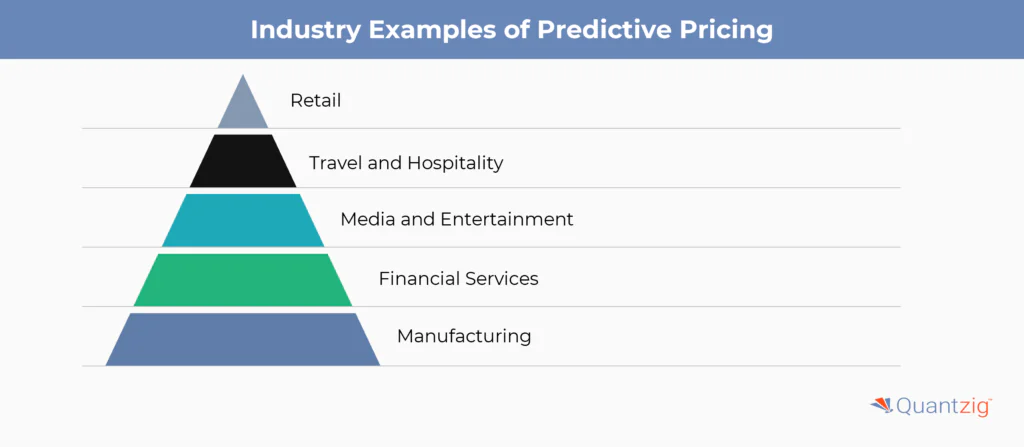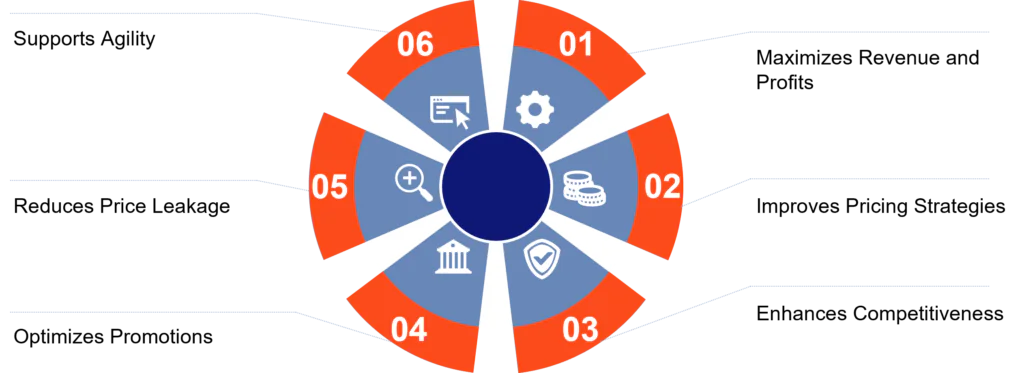Author: Associate Vice President, Analytics and Data Strategy, Quantzig.
Companies today face the challenge of optimizing pricing strategies to boost profitability and growth. Predictive pricing analytics offers a powerful solution by utilizing advanced data analysis and machine learning to forecast consumer behavior and optimize pricing structures.
Key benefits of predictive pricing analytics include:
- Improved financial performance through data-driven pricing strategies.
- Enhanced customer satisfaction by aligning prices with consumer behavior.
- Competitive advantage gained through real-time insights and market trends.
Quantzig’s predictive pricing analytics services help businesses transform pricing strategies, drive profitability, and achieve sustainable growth.
Book a demo to experience the meaningful insights we derive from data through our analytical tools and platform capabilities. Schedule a demo today!
Request a Free DemoTable of Contents
What is Predictive Pricing?
Predictive pricing is a data-driven strategy where companies set prices based on collected and analyzed data. Predictive analytics, the backbone of predictive pricing, uses modern technology to gather data and make forecasts that help businesses determine optimal prices to maximize profitability, revenue, and alignment with market dynamics. While some organizations use predictions for fixed pricing, predictive pricing typically refers to dynamic pricing and automation, often leveraging AI, machine learning, and data mining tools to execute the process without human intervention.
Why is Predictive Pricing Analytics Important?

Pricing analytics is crucial for businesses looking to optimize profitability and drive growth. Here are some key reasons why pricing analytics is important:
- Maximizes Revenue and Profits: By analyzing customer demand, price sensitivity, and competitive pricing, businesses can set prices that maximize revenue and profits.
- Improves Pricing Strategies: Pricing analytics provides data-driven insights to develop more effective pricing strategies tailored to specific products, customer segments, and market conditions.
- Enhances Competitiveness: Understanding competitor pricing and market trends allows businesses to set prices that are competitive while still maintaining healthy margins.
- Optimizes Promotions: Analyzing the impact of past promotions and discounts helps businesses determine the most effective promotional strategies to drive sales.
- Reduces Price Leakage: Identifying areas where prices are being discounted unnecessarily or where customers are paying less than the optimal price helps minimize revenue leakage.
- Supports Agility: With real-time pricing analytics, businesses can quickly adjust prices in response to changing market conditions, competitive moves, or shifts in customer demand.
What are the Types of Pricing Analytics?
| Type of Pricing Analytics | Description |
|---|---|
| Predictive Pricing | Uses historical data, machine learning, and predictive modeling to forecast optimal prices based on factors like customer demand, market trends, and competitor pricing. |
| Prescriptive Pricing | Leverages optimization algorithms to recommend the best pricing strategies and price points to achieve specific business objectives like revenue maximization or profit optimization. |
| Dynamic Pricing | Adjusts prices in real-time based on factors like supply, demand, competition, and customer willingness to pay. Often used in industries like airlines, hotels, and e-commerce. |
| Competitive Pricing | Analyzes competitor pricing data to set prices that are aligned with the market and maintain a competitive edge. |
| Value-Based Pricing | Determines prices based on the perceived value of the product or service to the customer rather than just the cost of production. |
| Segmented Pricing | Tailors prices for different customer segments based on factors like demographics, purchase history, and price sensitivity. |
| Bundled Pricing | Packages multiple products or services together at a discounted price to drive sales and increase average order value. |
| Subscription Pricing | Offers a recurring payment model for access to products or services, often with tiered pricing based on features or usage. |
| Penetration Pricing | Sets low initial prices to quickly gain market share, then gradually increases prices over time. |
| Skimming Pricing | Starts with high prices and gradually lowers them to capture the maximum willingness to pay from different customer segments. |
How Can Predictive Pricing Analytics Unlock Profitability?
Pricing analytics can unlock profitability in several ways:
- Price Optimization: By analyzing customer willingness to pay, price sensitivity, and the competitive landscape, businesses can determine the optimal price points that maximize revenue and profits.
- Promotion Optimization: Predictive analytics can help businesses determine the most effective promotions and discounts to drive sales while minimizing profit erosion.
- Targeted Pricing: Pricing analytics services enable businesses to tailor prices to specific customer segments based on factors like purchase history, price sensitivity, and lifetime value.
- Dynamic Pricing: Real-time pricing analytics allows businesses to adjust prices dynamically based on factors like supply, demand, and competitor pricing to capture maximum value.
- Margin Management: Pricing analytics helps businesses identify areas where margins can be improved through better pricing strategies, targeted promotions, or cost optimization.
- Pricing Experimentation: By running controlled pricing experiments, businesses can test different pricing strategies and quickly determine the most effective approaches.
- Pricing Automation: Leveraging AI and machine learning, pricing analytics can automate pricing decisions, allowing businesses to rapidly adjust prices in response to market changes.
By leveraging the power of pricing analytics tools, businesses can make more informed, data-driven pricing decisions that unlock profitability, drive growth, and maintain a competitive edge in the market.
How does Predictive Pricing Analytics Work?
Predictive price optimization works by leveraging predictive analytics to determine customer behavior, market trends, and competitive forces. The process involves:
- Data Collection: Gathering data from various sources, such as sales records, customer behavior, market trends, and competitive intelligence.
- Data Preprocessing: Cleaning, structuring, and organizing the data for analysis.
- Feature Engineering: Selecting and creating relevant features from the data.
- Model Training: Training the predictive pricing algorithm using preprocessed data.
- Model Validation: Evaluating the model’s performance and accuracy.
- Price Forecasting: Generating price forecasts based on market conditions and input data.
- Price Adjustment: Adjusting prices in real-time based on the forecasts.
This process helps businesses optimize prices to maximize revenue and profitability.
Technology Trends Shaping the Future of Predictive Pricing
As businesses seek to stay competitive in a rapidly evolving market, leveraging cutting-edge technologies is crucial for optimizing pricing strategies. Here are some key technology trends shaping the future of predictive pricing:

| Trend | Details |
|---|---|
| Artificial Intelligence (AI) and Machine Learning (ML) | – AI and ML algorithms are becoming more sophisticated, enabling more accurate price forecasting and optimization. – AI-powered pricing engines can automatically adjust prices in real-time based on market conditions. |
| Big Data and Advanced Analytics | – The ability to collect, process, and analyze massive amounts of pricing data from various sources is crucial for effective predictive pricing. – Big data allows for more granular segmentation, personalization, and optimization of prices. |
| Cloud Computing | – Cloud-based pricing platforms make it easier and more cost-effective for businesses to implement predictive pricing. – Scalable cloud infrastructure supports the computing power needed for AI/ML-driven pricing. |
| Internet of Things (IoT) | – IoT sensors can provide real-time data on inventory levels, demand, and market conditions to feed into predictive pricing models. – Connected devices enable dynamic pricing and personalized offers at the point of sale. |
| Blockchain | – Blockchain can help create transparent, tamper-proof pricing records and smart contracts. – Distributed ledger technology enables secure, decentralized pricing platforms. |
These technology trends are revolutionizing predictive pricing, allowing businesses to implement more precise, responsive, and personalized pricing strategies. Staying ahead of these trends will be key to maintaining a competitive edge in the market.
Quantzig’s Expertise in Predictive Pricing Analytics for a Leading M&E Player Headquartered in Europe
| Particulars | Description |
| Client | An M&E player with operations across the globe |
| Business Challenge | To improve their pricing and profitability |
| Business Impact | 8% increase in profitability, better use of investment budgets |
About the Client
The client is a leading media and entertainment industry player headquartered in Europe. The client aimed to enhance their pricing strategies to improve outcomes and overall profitability.
The Business Challenges Faced by the Client
The key business challenges faced by the client in the media and entertainment industry include:
- Intense competition in personal lines of business, making price optimization critical
- Launching new services in new and niche customer segments, requiring the right pricing strategy
- Losing valuable clientele to competitors due to ineffective pricing strategies
- Need to employ pricing analytics to improve pricing and profitability
- Requirement for effective pricing analytics-based solutions to optimize current spending patterns
- Difficulty in accurately forecasting product demand
- Lack of a robust price optimization model to control inventory costs and improve customer satisfaction
- Inadequate tools to develop an effective pricing strategy and improve profit margins
To address these challenges, the client approached Quantzig, a leading provider of pricing analytics solutions. Our experts aimed to develop effective b2b pricing analytics-based solutions to help the client improvise on their current spending patterns, accurately forecast demand, and develop a robust price optimization model to control inventory costs and improve customer satisfaction.
Predictive Pricing Analytics Solutions Offered by Quantzig

Our B2B pricing analytics experts developed a comprehensive pricing optimization model that included:
- Competitive Management Analysis: Analyzing competitors’ pricing strategies to identify opportunities for differentiation.
- Cost Models: Developing cost structures to ensure pricing aligns with operational costs.
- Optimization Techniques: Implementing advanced algorithms to optimize pricing based on customer demand and market trends.
- Customer Elasticity Models: Understanding how customers respond to price changes to set optimal prices.
Impact Delivered from Predictive Pricing Analytics
The pricing analytics models led to significant improvements in the client’s financial performance:
- Revenue Increase: The client saw an 8% increase in revenue, surpassing their highest profit margin.
- Profitability Enhancement: The solution helped develop an effective price optimization model, leading to substantial improvements in profit margins.
- Maverick Spending Reduction: The b2b pricing analytics solution helped reduce maverick spending by optimizing investment budgets.
- Better Investment Budgets: The client developed more effective investment budgets through the pricing analytics solution.
Overall, the pricing analytics tools had a profound impact on the client’s profitability, enabling them to make data-driven pricing decisions that drove business growth and improved financial performance.
Experience the advantages firsthand by testing a customized complimentary pilot designed to address your specific requirements. Pilot studies are non-committal in nature.
Request a Free PilotSome Industry Examples of Predictive Pricing

Here are some examples of predictive pricing in action across different industries:
1. Retail
- Retailers use predictive analytics to optimize prices based on demand, competition, and customer behavior.
- Retailers leverage AI to dynamically price products at the shelf-level based on factors like inventory and foot traffic.
2. Travel and Hospitality
- Airlines use predictive pricing to adjust fares based on factors like seasonality, day of week, and competitor pricing.
- Hotels employ dynamic pricing to optimize room rates based on demand, events, and competitor pricing.
3. Media and Entertainment
- Media and entertainment companies use predictive analytics to personalize pricing and promotions for different customer segments.
- Video game companies offer dynamic pricing and bundles based on player behavior and demand.
4. Financial Services
- Banks use predictive pricing for loan and credit card offers based on customer risk profiles and market conditions.
- Insurance companies employ predictive analytics to price policies based on customer risk factors and claims history.
5. Manufacturing
- Industrial equipment manufacturers use predictive pricing to optimize prices for different customer segments, geographies and sales channels.
- Consumer packaged goods companies leverage AI-powered pricing engines to dynamically adjust wholesale prices based on retailer demand.
These examples illustrate how predictive pricing is being applied across diverse industries to drive revenue growth, profitability and competitive advantage through data-driven pricing strategies.
Get started with your complimentary trial today and delve into our platform without any obligations. Explore our wide range of customized, consumption driven analytical solutions services built across the analytical maturity levels.
Start your Free TrialConclusion
Leveraging pricing analytics models can significantly enhance profitability for many industries. By utilizing Predictive Analytics and Predictive Price Modeling, companies can optimize pricing strategies, aligning them with market trends and consumer behavior. Advanced Predictive Pricing Algorithms and Predictive Pricing Models enable Dynamic Pricing and precise Predictive Price Optimization. Incorporating Machine Learning and Artificial Intelligence into Predictive Analytics Tools and Predictive Software enhances the accuracy of Data Analysis, supporting better Decision-Making Processes. Ultimately, these Predictive Pricing Strategies drive increased revenue and profitability, ensuring a competitive edge in the media and entertainment industry.






